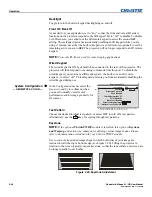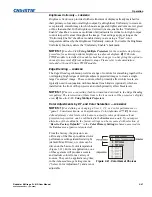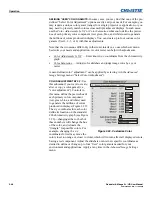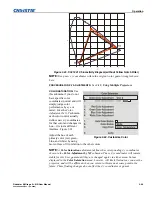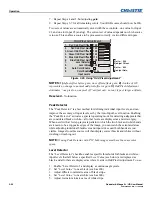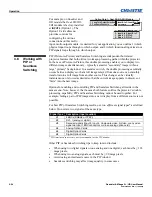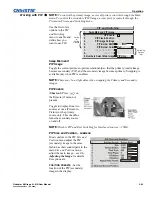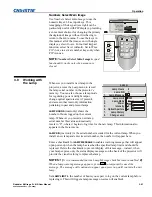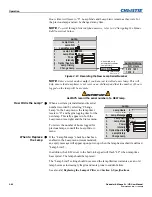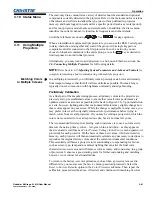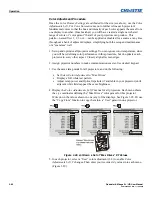
Operation
Roadster & Mirage S+/HD User Manual
3-53
020-100002-04 Rev. 1 (12-2008)
Level Value
Level Value
defines the value to be used by the Level Detector in recognizing blacks
and whites. See
Level Detector
, above.
Aspect Ratio Overlay
Selecting this option with a checkmark will overlay a number of common aspect ratio
boxes on top of the source image. This is very helpful during the setup of the
projector and can be turned off after desired specifications have been achieved.
LiteLOC™ Calibration
NOTES: 1)
LiteLOC™ Calibration takes up to two minutes.
2)
For best results,
allow the projector to warm up for 15 minutes prior to calibration.
LiteLOC™ Calibration defines the range of power needed to maintain lamp
brightness. Select
Calibrate LiteLOC
for calibration using your projector’s unique
specifications (recommended) rather than standard specifications. The projector will
revert to the default back up in the event of a power failure. Refer to the
Lamp
menu
for more details.
Use Default Settings
Calibrate LiteLOC
1.
2.
Intelligent Lens System (ILS
™
) Calibration
This option allows you to choose between three types of lens calibrations.
Reference
calibration
determines a reference point that is used as a defined starting position for
relative motion of the lens. All positioning is measured from this reference point. A
reference
calibration
is lost when power is removed from the projector and will
occur on every power up as long as ILS
™
is enabled. A
motion
calibration
determines the characteristics of each motor and values are saved in the projector’s
memory. If ILS
™
is enabled and a
motion calibration
has previously been done, the
projector will automatically recall these settings from memory when it’s being
powered up and a
motion
calibration
will not take place. A
full
calibration
performs
both a
reference
and
motion
calibration
.
Automatic ILS Lens Calibration
When this option is selected (default) and the projector is in ILS mode, the projector
will perform a lens calibration on each power-up. During calibration, the shutter will
be closed and the status LED will display ‘LC’. If ILS is not selected, the ALC
setting will be ignored. If, during power-up, ALC is not selected and ILS is, the last
stored location from the previous ILS calibration will be assumed to be true and the
lens will moved to that position upon power-up if necessary.
The two “Option Card” entries In the Configuration menu identify which optional
input modules (a.k.a. cards) are present at
INPUT 5
(Option 1) and
INPUT 6
(Option 2).
If either of these option slots is empty, the corresponding read-only menu entry does
nothing. If there is a module installed, the corresponding menu entry may activate a
submenu of further options pertaining to that module.
System
Configuration
OPTIONAL INPUT MODULES








